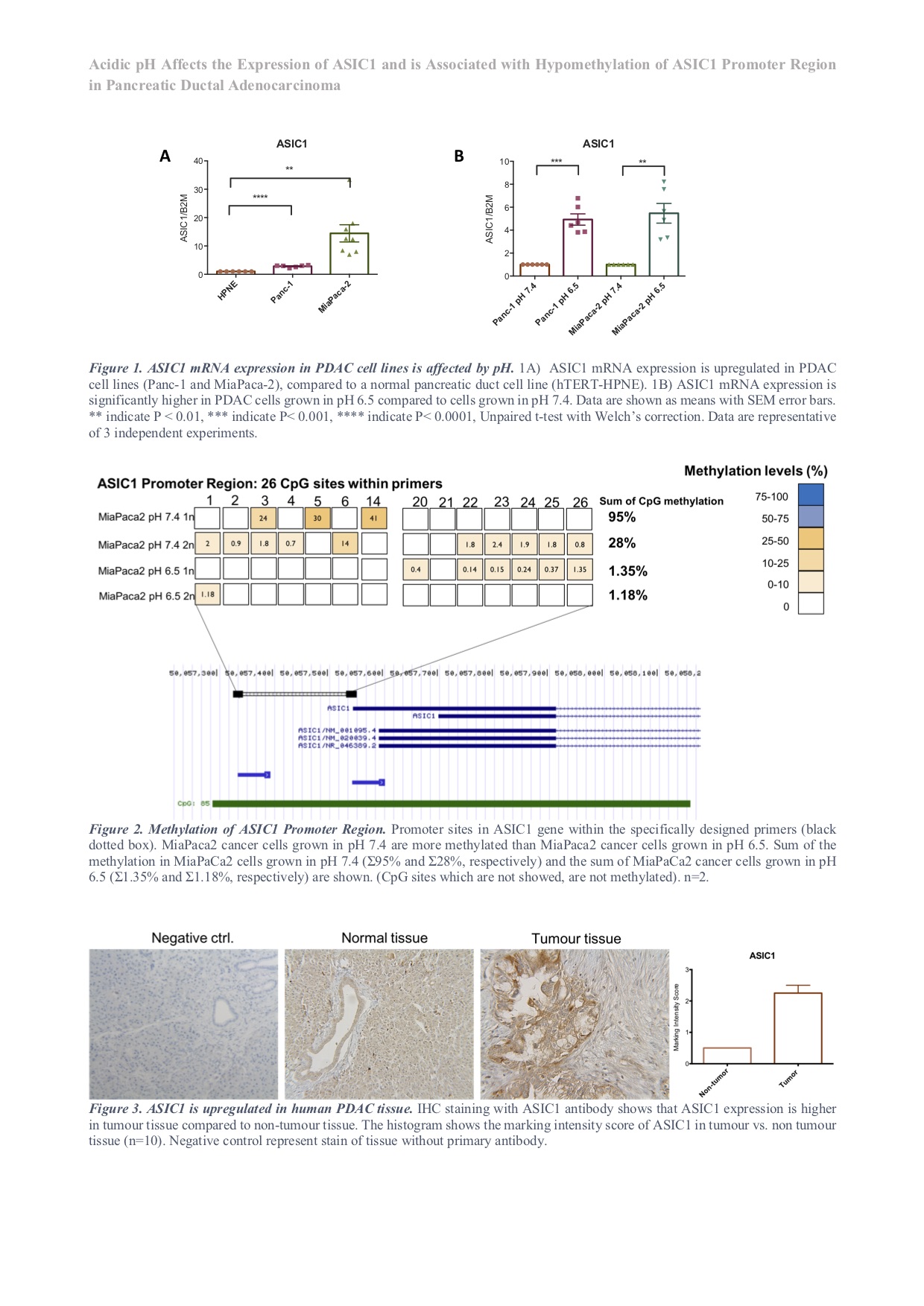The development and progression of pancreatic ductal adenocarcinoma (PDAC) are linked to the physiology and microenvironment of the exocrine pancreas. The temporally highly variable extracellular pH landscape in pancreatic ducts challenges epithelial cells in maintaining a constant intracellular pH [1]. We hypothesize that changes in pH affect cellular processes leading to an altered expression of ion channels. This in turn helps driving transformation from usual to malignant cell behaviour. We investigate if the already known dysregulation of the acid sensing ion channel 1 (ASIC1) [2] is regulated by DNA methylation. To investigate if a prolonged acidic pH treatment has an effect on DNA methylation and thereby the expression of ASIC1, PDAC cell lines Panc-1 and MiaPaca-2 were incubated in medium with a pH of 7.4 or 6.5 over 30 days. A ductal-like control cell line hTERT-HPNE was grown in pH 7.4. Under these conditions, mRNA expression of ASIC1 was obtained by qPCR, and DNA methylation levels were obtained by sodium bisulfite-treated genomic DNA sequencing. Human PDAC tissue samples from non-tumour and tumour tissue were used to acquire the ASIC1 expression by classical immunohistochemical analysis (IHC). Our preliminary IHC results showed that ASIC1 tends to be upregulated in tumour tissue compared to normal tissue (n=10, intensity score in tumour =2, vs. 0 in non-tumour tissue). ASIC1 was significantly upregulated in Panc-1 and MiaPaca-2 cell lines, compared to the control hTERT-HPNE (n=3, Welch Correction test, p< 0.0001 and p<0.01, respectively). The acidic pH treatment (pH 6.5) resulted in further ASIC1 upregulation, when compared to cells treated with pH 7.4, both in Panc-1 and MiaPaca-2 cells (n=3, Welch Correction test, p< 0.001 and p< 0.01, respectively). To test our hypothesis that ASIC1 gene expression is regulated by DNA methylation, we performed bisulfite sequencing interpreted by a semi-quantitative analysis, where the ratio between the peak of thymines and cytosines was measured. Different CpG islands of the ASIC1 promoter region were to some extent methylated in DNA from MiaPaca-2 cells treated with pH 7.4 (n=2), sum of methylation in 26 CpG islands was Σ95% and Σ28%, respectively. In contrast, CpG islands of the ASIC1 promoter region from MiaPaca-2 treated with pH 6.5, had lower DNA methylation levels (n=2), sum of methylation in 26 CpG islands was Σ1.35% and Σ1.18%, respectively. Collectively, these results show that ASIC1 is upregulated in human tissue, and is significantly upregulated in PDAC cell lines Panc-1 and Miapaca-2. Prolonged exposure to acidic pH, results in an upregulation of ASIC1 in both cell lines. This upregulation might be governed by DNA methylation of specific ASIC1 CpG sites, suggesting that the ASIC1 gene promoter region is hypomethylated in cells exposed to prolonged acidic treatments. Further studies should assess ASIC1 expression and DNA methylation status in human tissue. Furthermore, a quantitative analysis and method to show that DNA methylation levels are reversible can reveal that the upregulation of ASIC1 in PDAC is governed by DNA methylation and affected by the temporally highly variable pH landscape in pancreatic ducts.
Future Physiology 2021 (Virutal) (2021) Proc Physiol Soc 47, OC24
Oral Communications: Acidic pH affects the expression of ASIC1 and is associated with hypomethylation of ASIC1 promoter region in pancreatic ductal adenocarcinoma
Julie Schnipper1, Pierre Rybarczyk2, Audrey Vincent3, Isabelle Dhennin-Duthille1, Mathieu Gautier1, Riad Tebbakha2, Ahmed Ahidouch1, 4, Halima Ouadid-Ahidouch1
1 Laboratory of Cell and Molecular Physiology, Faculty of Sciences, University of Picardie Jules Verne, Amiens, France 2 Anatomy and Pathology Department, Amiens Hospital, University of Picardie Jules Verne, Tumorotheque of Picardie, Amiens, France 3 Inserm UMR-S 1172, Jean-Pierre Aubert Research Center, CHU Lille, University of Lille, Lille, France 4 Biology department, University Ibn Zohr, Agadir, Morocco
View other abstracts by:
Where applicable, experiments conform with Society ethical requirements.

